Stuebner Airline Veterinary Hospital

Surgical & Ultrasound FAQs
Is the anesthetic safe?
Today's modern anesthetic monitors have made surgery much safer than in the past. Here at Stuebner Airline & Champions Veterinary Hospitals, we do a thorough physical exam on your pet before administering anesthetics, to ensure that a fever or other illness won't be a problem. We also adjust the amount and type of anesthetic used depending on the health of your pet.
Preanesthetic blood testing is important in reducing the risk of anesthesia. Every pet needs blood testing before surgery to ensure that the liver and kidneys can handle the anesthetic. Even apparently healthy animals can have serious organ system problems that cannot be detected without blood testing. If there is a problem, it is much better to find it before it causes anesthetic or surgical complications. Animals that have minor dysfunction will handle the anesthetic better if they receive IV fluids during surgery. If serious problems are detected, surgery can be postponed until the problem is corrected.
We offer three levels of in-house blood testing before surgery, which we will go over with you when you bring your pet in. Our doctors prefer the more comprehensive screen because it gives them the most information to ensure the safety of your pet. For geriatric or ill pets, additional blood tests, electrocardiograms, or x-rays may be required before surgery as well.
It is important that surgery be done on an empty stomach to reduce the risk of vomiting during and after anesthesia. You will need to withhold food for at least 8 to 10 hours before surgery. Water can be left down for the pet until the morning of surgery.
Will my pet have stitches?
For many surgeries, we use absorbable sutures underneath the skin. These will dissolve on their own, and do not need to be removed later. Some surgeries, especially tumor removals, do require skin stitches.
With either type of suture, you will need to keep an eye on the incision for swelling or discharge. Most dogs and cats do not lick excessively or chew at the incision, but this is an occasional problem you will also need to watch for.
If there are skin sutures, these will usually be removed 10 to 14 days after surgery. You will also need to limit your pet's activity level for a time and no baths are allowed for the first 10 days after surgery.
Will my pet be in pain?
Anything that causes pain in people can be expected to cause pain in animals. Pets may not show the same symptoms of pain as people do; they usually don't whine or cry, but you can be sure they feel it. Pain medications needed will depend on the surgery performed. Major procedures require more pain relief than things like minor lacerations.
For dogs, we may recommend an oral anti-inflammatory the day after surgery and several days after to lessen the risk of discomfort and swelling. We use newer medications, which are less likely to cause stomach upset and can be given even the morning of surgery. The cost of the medication ranges from $15 to $30, depending on the size of your dog.
Because cats do not tolerate standard pain medications such as aspirin, ibuprofen, or Tylenol, we are limited in what we can give them. Recent advances in pain medications have allowed for better pain control in cats than ever before. We administer a pain injection 10 minutes prior to surgery. After surgery, pain medication is given on a case-by-case basis. Any animal that appears painful will receive additional pain medication.
We use narcotic patches for some surgeries in dogs as well. The cost will depend on the size of the dog. Injectable pain medications may also be used after surgery on both dogs and cats. Providing whatever pain relief is appropriate is a humane and caring thing to do for your pet.
What other decisions do I need to make?
While your pet is under anesthesia, it is the ideal time to perform other minor procedures, such as dentistry, ear cleaning, or implanting an identification microchip. If you would like an estimate for these extra services, please call ahead of time. This is especially important if the person dropping the pet off for surgery is not the primary decision maker for the pet's care.
When you bring your pet in for surgery, we will need 5 to 10 minutes of time to fill out paperwork and make decisions on the blood testing and other options available. When you pick up your pet after surgery you can also plan to spend about 10 minutes going over your pet's home care needs.
We will call you the night before your scheduled surgery appointment, to confirm the time you will be dropping your pet off and to answer any questions you might have. In the meantime, please don't hesitate to call us with any questions about your pet's health or surgery.
What is ultrasound?
Ultrasound is a painless method for imaging the body using very high-pitched sound frequencies (higher than the human ear can hear).
Ultrasound is commonly used in both veterinary and human medicine for a wide variety of problems, including diseases of the liver, kidneys, bladder, stomach, intestines, adrenal glands, pancreas, spleen, reproductive tract, blood vessels, heart (often referred to as echocardiography), thorax, eye, and muscles/tendons. Ultrasound is less useful for imaging structures like bone or air-filled structures like the lung.
Is ultrasound safe?
Yes, an ultrasound is very safe. The main benefit of ultrasound is that it can provide useful information about the body without invasive surgery, injection of dyes, or ionizing radiation. In fact, you may be most familiar with ultrasound due to its common use in the imaging of pregnant women and their unborn babies.
What happens during an ultrasound?
During an abdominal ultrasound, the patient is usually placed on their back in a soft, padded trough. Although some pets are initially slightly anxious, almost all pets relax and remain calm once they realize that nothing painful is happening. For pets that cannot, or will not, lie still on their backs, in some cases, the examination can be performed with the patient laying on their side.
The hair on the underside of the belly will be shaved and a lotion will be applied to the skin. The images are obtained by placing the transducer (a smooth, handheld object, similar in size and shape to a small TV remote control) on the patient's skin and slowly moving the transducer around on the skin. Many patients go to sleep during the procedure!
For a heart ultrasound (echocardiogram), the patient lies on their side on a padded table. The table has a small hole so that the transducer can be placed under the pet and in contact with the skin. A small patch of hair will need to be shaved in the 'underarm' area.
How long does the examination take?
Most exams take between 30-60 minutes. Due to the nature of our business with emergency and critical patients, sometimes a more critical case may take priority and your pet's exam may need to be postponed. This is similar to the triage that occurs in human hospitals.
Can I be present during the examination?
Unfortunately, we are unable to allow owners to be present in the ultrasound room.
Can you tell me the results of the examination?
We will be happy to schedule a consultation with one of our veterinarians to discuss the ultrasound findings at your request. Often your veterinarian will request such a consultation after discussing the results with our doctors.
Since accurate interpretation requires time, expertise, and thought, as well as a physical examination of your pet, additional fees will be assessed. We will be happy to discuss this with you at any time.
What should I do to prepare for the ultrasound procedure?
Please do not feed your pet for 8-12 hours prior to the examination. Water is permitted. It is very important that your pet have an empty stomach in order to allow proper imaging of the area near the stomach. There are some diseases/situations where food should NOT be withheld; contact your veterinarian to determine if your pet is healthy enough for fasting.
Please do not let your pet urinate for the 3 hours prior to your appointment. A full urinary bladder is essential.
Can I wait for the exam to be completed? Can I drop the pet off and come back later?
Either option is ok. If you choose to drop the pet off with us, please leave us a phone number where you can be easily contacted.

